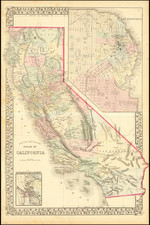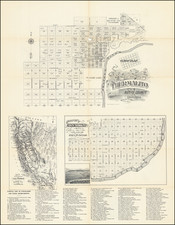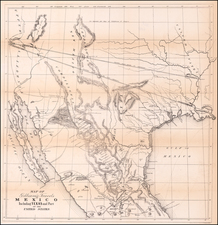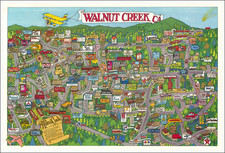Rare early view of the Mission San Miguel Arcangel, most likely taken from an original drawing by Edward Vischer in 1863-1864.
Printed on heavy stock paper, the view would seen to have been separately published.
The main adobe mission buildings can be seen at center. The large mission church is on the right side of the structures, while a long, low building marked by rows of large archways can be seen protruding from the side of the church. In the foreground, several Californios on horseback and robed figure can been seen, along with two horses at a well. Rolling hills sparsely dotted with trees can be seen in the background. A stagecoach is visible in the background at right.
We believe that this resent image was drawn from a rare Edward Vischer print entitled Church (the interior yet kept in good condition) of the Mission of San Miguel, and Ruins of the Casa Principal and Outbuildings. Sheriff and posse conducting a band of criminals towards San Luis Obispo. The original Vischer is virtually unobtainable. A photograph of a similar drawing exists in the USC Doheny collection.
The originals from which this view might have come all suggest a dating between the 1860s and mid-1880s, with the paper and printing method suggestive of a date at the end of the 19th Century.
Mission San Miguel
Mission San Miguel Arcangel was founded on July 25, 1797 by Father Lausen and is named for Saint Michael the Archangel. San Miguel was the 16th of the California Missions.
The location of the Mission was considered ideal since it was situated in a fertile valley and near two rivers, the Nacimiento and the Salinas. The site was also within easy travel distance from the San Joaquin Valley which had a large population of Native Americans which the Franciscan padres hoped to convert to Christianity. A small wooden chapel was originally built but within a year it was replaced by a larger adobe church, unfortunately it destroyed by fire in 1806. The current church was built between 1816 and 1818. The interior walls of the church were painted by Estevan Munras, a Spanish artist, in 1818.










![[Limited Edition of 33] The Sculpture & Art of Jo Mora](https://storage.googleapis.com/raremaps/img/small/94900.jpg)
![[ Baja California ]](https://storage.googleapis.com/raremaps/img/small/85440.jpg)


